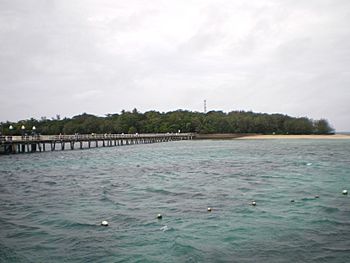Green Island (Queensland) facts for kids
|
Native name:
Wunyami
|
|
|---|---|

Green Island jetty
|
|
| Geography | |
| Location | Coral Sea |
| Area | 0.15 km2 (0.058 sq mi) |
| Administration | |
|
Australia
|
|
| State | Queensland |
| LGA | Cairns Region |
| Green Island Cairns, Queensland |
|||||||||||||||
|---|---|---|---|---|---|---|---|---|---|---|---|---|---|---|---|
| Population | 20 (2021 census) | ||||||||||||||
| • Density | 5.7/km2 (15/sq mi) | ||||||||||||||
| Postcode(s) | 4871 | ||||||||||||||
| Area | 3.5 km2 (1.4 sq mi) | ||||||||||||||
| Time zone | AEST (UTC+10:00) | ||||||||||||||
| LGA(s) | Cairns Region | ||||||||||||||
| State electorate(s) | Cairns | ||||||||||||||
| Federal Division(s) | Leichhardt | ||||||||||||||
|
|||||||||||||||
Green Island (originally Dabuukji) is a beautiful marine island and a small community in the Cairns Region, Queensland, Australia. It is a popular tourist destination. In 2021, only 20 people lived on Green Island.
Contents
About Green Island
Green Island is a special type of island called a coral cay. It is located about 27 kilometres (17 miles) offshore from Cairns, Queensland, Australia. The island is part of the amazing Great Barrier Reef Marine Park, which is a World Heritage Area.
The island is completely surrounded by a beautiful coral reef. This reef is protected as part of the Green Island National Park. Most people visit Green Island for a day trip. There is also a luxury resort with 46 rooms for those who want to stay longer.
Island Plants
Green Island has many different kinds of plants. You can find dry coastal plants near the beach. There is also a thick vine rainforest. The island does not have natural freshwater springs. All the plants get their water from rainwater. There is also a small amount of freshwater stored under the island.
History of Green Island
Green Island was formed about 6,000 years ago. Waves slowly built up sand, coral, and other bits of rock. These materials were deposited onto the island's coral foundations.
Traditional Owners
The local Aboriginal people, especially the Gungganyji language group, have a strong connection to the island. They call it Dabuukji. The name Dabuukji might mean that the island was once larger. It may have had a freshwater marsh or well in its centre. Another idea is that it relates to a story about a turtle getting holes in its nose (nostrils) here. It could also refer to special rituals for young Gungganyji men.
Local Aboriginal people also say that in the Dreamtime, Dabuukji was much bigger. They believe the island we see today is only a small part of the original island. They also traditionally saw the island as a wunjami, meaning "a place haunted by spirits."
European Naming and Early Use
The Queensland Government officially named the island Green Island. This name was given by Lieutenant James Cook on June 10, 1770. He might have named it for its green plants. Or, it could have been named after Charles Green. Charles Green was an astronomer on Cook's ship, the Endeavour.
The first non-Aboriginal person known to live on the island was James Seton Veitch Mein in 1857. He set up a station to smoke beche-de-mer (sea cucumbers). In 1899, coconut palms were planted on the island. These were meant to provide food for sailors who might get shipwrecked.
Tourism Begins
Since the early 1900s, tourism has been the main activity on Green Island. A guest house was built in the 1930s. In 1954, an underwater observatory was added. This allowed visitors to see the marine life without getting wet.
In 1970, Queen Elizabeth II, the Duke of Edinburgh, and Princess Anne visited Green Island. They arrived by the royal yacht Britannia. Their visit was short, lasting only 30 minutes.
The current resort, Green Island Reef Resort, opened in 1994. To provide water for the resort, a seawater desalination plant was built in 2001. This plant turns seawater into drinking water.
Population
Green Island has a very small population. In 2016, there were 25 people living there. By 2021, the population was 20 people.
Education
There are no schools directly on Green Island. Children living there usually attend schools in Cairns. Other options include distance education, where students learn from home, or boarding schools.
Getting to Green Island
It's easy to get to Green Island! Many commercial boats, helicopters, and seaplanes offer transport. The most common way to reach the island is by a 45-minute catamaran ride from the city of Cairns on the mainland.
Images for kids
-
A Great Barrier Reef ferry, Green Island





